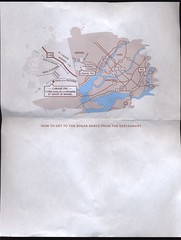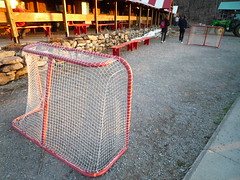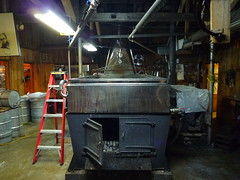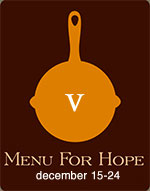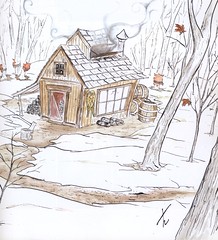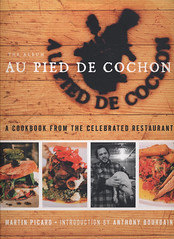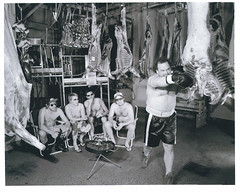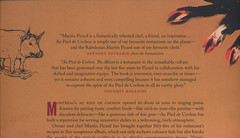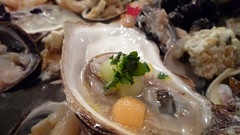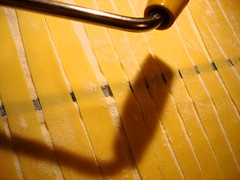 fig. a: maple sugaring in the northern woods again
fig. a: maple sugaring in the northern woods again
Those of you who've been reading AEB over the last few years will know that we've long had an affection for scenes such as the one above: old prints of homesteaders practicing the alchemy of turning maple sap into maple syrup and maple sugar. You'll also know that we're big fans of the cuisine--yes, cuisine--of the traditional Québécois cabane à sucre: the beans, the ham, the cretons, and all the other assorted pork dishes, the ketchup aux fruits, the tire d'érable, and so on. You might also have noticed that Michelle's birthday is around this time of year, right in the thick of sugaring-off season. What you might not know, however--especially if you don't live in this region--is that if you wanted to take a sugar shack fanatic out to celebrate her birthday with a group of people at a traditional cabane à sucre, you'd have literally dozens upon dozens of establishments to choose from within a 100-150 km radius, but you'd be hard-pressed to find one of exceptional quality (top-notch ingredients + top-notch technique). Believe me, we've tried, and though we've found some good cabanes à sucre, ones worthy of a casual, slightly kitschy weekend outing, we've yet to find one that's worthy of a birthday party. Which means that as much as the idea of taking a group of people out to a traditional, rustic, intimate, backwoods sugar shack for Michelle's birthday appeals to us, it's never really been in the cards.
Now, rewind, if you will, for just a moment or two, to about three weeks ago. We were strolling down Ste-Catherine W. on our way to a movie when we looked in the window at Westcott Books and saw this handsome book:
 fig. b: The Maple Sugar Book
fig. b: The Maple Sugar Book
The store was closed at the time, but the cover left such an impression on us that the very next day we made a special trip back to that part of town to take a closer look. And when we did, we liked what we saw, so we took that first edition of Helen & Scott Nearing's The Maple Sugar Book (1950) up to the front counter, chatted up the owner about his numerous bookstore cats, paid for the book, and took it home with us.
The Nearings' book is divided into three parts--roughly, the history of maple sugaring, the practice of maple sugaring, and the philosophy of life that goes along with maple sugaring--plus an appendix on maple recipes of all sorts (from candied sweet potatoes to maple divinity fudge), and it starts off with the kind of bang you might expect from the people who more or less pioneered the 20th century back-to-the-land movement:
FOREWORD
We had three things in mind when we set ourselves to write this book. The first was to describe in detail the process of maple sugaring. The second was to present some interesting aspects of maple history. The third was to relate our experiments in homesteading and making a living from maple to the larger problem faced by so many people nowadays: how should one live?
[...]
What we have been developing here in the Green Mountains is a source of livelihood that leaves us time and room to live life simply and surely and worthily. Henry Thoreau wrote in his journal on February 18, 1850: "There is little or nothing to be remembered written on the subject of getting an honest living. Neither the New Testament nor Poor Richard speaks to our condition. I cannot think of a single page which entertains, much less answers, the questions which I put to myself on this subject. How to make the getting our living poetic! for if it is not poetic, it is not life but death that we get." Sugaring can bring one an honest living. And anyone who has ever sugared remembers the poesy of it to the end of his days...
We haven't exactly packed up our city-living ways, found ourselves a tract of hardscrabble land, and started homesteading (yet), but the Nearings'
The Maple Sugar Book is definitely a great read for a book that devotes so much type to discussions of buckets, pipes, and evaporators, and we've been talking about it off and on for weeks.
In fact, it became such an important of our lives that when we started thinking about our annual sugar shack pilgrimage this year, perversely, the book actually inspired us to stay in the city and stage a full-blown
cabane à sucre extravaganza ourselves. We'd be missing out on the fresh air and the woods, of course, but we'd be saving on car rental fees and gas, there'd be little risk of kitsch, we'd be able to guarantee that our food would be both tasty and of a high quality, we'd be able to control the stereo (i.e. we'd be able to play our La Bolduc records if we so desired, but we could just as easily play a Brigitte Fontaine & Areski record) and therefore the ambiance, and, who knows, maybe we'd be able to create some small-scale poesy right at home. We got so excited about the idea, that we decided to throw this sugar shack party for Michelle's birthday.
Now, before you get all hot and bothered because we left out the pea soup, the
oreilles de crisse, and the
pets de soeur, you should know that our menu was our own personal Dream Team: a few classics, like baked beans and
ketchup aux fruits, alongside some dishes that you'd probably never find at a
cabane à sucre but you'd be happier if you did (or, rather,
we'd be happier if
we did). The spread went as follows: two
tourtières, two maple-braised pork shanks, two batches of baked beans (one with yellow eye beans, the other with soldier beans), a massive batch of cole slaw,
ketchup aux fruits,
cornichons, cheddar cheese with crackers and jerusalem artichoke relish, and a can of maple syrup for all those willing to add a little magic to the mix, plus apple crumble with maple frappé for dessert. The tablecloth was of the red & white checked variety, and Michelle had decorated the table with hay to give things a countrified feel (okay, so we threw in
a little kitsch). The view from our specially designed AEB tablecam looked like this:
 fig. c: tourtière de ville, ketchup aux fruits, sirop d'érable
Tourtière
fig. c: tourtière de ville, ketchup aux fruits, sirop d'érable
Tourtière, of course, is
the classic French-Canadian meat pie. It might even be
the classic French-Canadian dish. Its roots stretch back to the days before the settlement of New France, but this is a dish which, in all of its varieties, became as French-Canadian as they come. The version we've been making since the fall of 2006 is a variation on the one found in Martin Picard & Co.'s
Au Pied de Cochon: The Album, and it's the best
tourtière recipe I've ever encountered. If you've ever had your typical modern, disappointing, bone-dry
tourtière, this is not one of them. The PDC recipe is unorthodox but ingenious, using mushrooms, white wine, and a grated potato to keep the filling moist and flavorful. The PDC original calls for braised pork shank meat and 1 braised pig's knuckle because when they make them at the restaurant they've got a lot of braised pork shanks and braised pigs' knuckles on-hand and available. We've replaced the 200 g / 7 oz of braised pork shank meat with the same amount of ground veal for simplicity's sake, and it turns out famously every time. However, you could use some of the braised pork shank meat from the maple pigs' feet / maple pork shanks recipe you see below, if you so desired, and I'm sure your
tourtière would turn out even more
hallucinant. Note: when it comes to the ground pork, don't get it too lean--no need to go overboard, but you want a bit of extra fat content for
tourtière. If that kind of thing concerns you, just go for a long walk or chop a little wood beforehand, but don't sell your
tourtière short. Note #2: the added nutmeg is my touch. Again, this is very unorthodox, so go ahead and leave it out if you like, but I think it really makes a difference. Just remember to go easy on the spices. They should definitely be present, but you don't want to overpower the filling with either clove or cinnamon (or nutmeg, for that matter).
tourtière de ville
1 pie dough recipe
500 g / 1 lb ground pork
250 g / 1/2 lb ground veal
1 medium onion, diced
3 cloves garlic, chopped
100 g / 4 oz mushrooms, chopped
100 ml / 1/2 cup white wine
1 egg yolk
1 tbsp butter
1 small potato, grated
1 small pinch ground cloves
1 small pinch ground cinnamon
1 small pinch ground nutmeg
salt and freshly ground pepper
In a large pot, sweat the onions and the garlic in the butter over medium-high heat. Add the mushrooms and continue cooking until the liquid released by the vegetables has evaporated. Add the white wine and continue cooking until the wine has evaporated as well. Add the ground pork, the ground veal, and the spices to the pot. Cook for 5 minutes, stirring to break up the chunks of meat. Add the grated potato and cook for another 10 minutes. Correct the seasoning, remove from the heat, and allow the mixture to cool.
Preheat your oven to 230º C / 450º F.
Roll out the pie dough and line a pie plate with half of it. Fill this with the ground meat mixture. Cover with the top half of the pie crust, brush it with the egg yolk, and poke or cut some holes in the top crust to allow the steam to escape during cooking.
Bake the pie in the oven for 15 minutes, then lower the heat to 175º C / 350º F and bake for another 20-25 minutes.
Serve with ketchup aux fruits.
Two pork shanks from our friends at Porc Meilleur came in at under $5 and they looked and tasted great. This recipe is straight out of the PDC cookbook and it's typical of PDC's genius: take one of the lowliest cuts off one of the lowliest meats and redeem it with a cup of maple syrup and a lot of love.
maple pigs' feet / pork shanks
2 pigs' trotters or pork shanks
2 carrots, peeled
1 head of garlic, whole
1 sprig thyme
6 boiler onions
2 l / 8 cups pork stock
250 ml / 1 cup maple syrup
100 ml / 7 tbsp vinaigrette
15 g / 1/4 cup fresh Italian parsley
salt and freshly ground black pepper
brine: 2 cups of salt dissolved in 4.5 l / 1.2 gallons of water
Soak the pigs' feet or pork shanks in the brine for 4-6 hours.
Put the meat, the onions, the carrots, the garlic and the thyme in an ovenproof casserole. Pour the stock and the maple syrup over the meat (ideally, the liquid should come about halfway up the sides of the feet/shanks). Bake uncovered in the oven at 160º C / 325º F, basting the meat with the broth every 30 minutes until they are well-glazed and have developed a nice crust. Bake for a total of four hours; the meat should be extremely tender and come easilly off the bone. Remove the meat, the carrots, and the onions from the broth and set aside.
Strain the stock and drippings into a saucepan; you should have approximately 2 cups total. Dice the carrots finely and add them and the onions to the pan. Bring to a boil over high heat and reduce by half. Remove from the heat and whisk in the vinaigrette. Add the parsley and correct the seasoning as needed.
Serve the meat with a generous amount of the sauce poured overtop.
Vinaigrette:
1 cup vegetable oil
50 ml Dijon mustard
50 ml red wine vinegar
Whisk together the mustard, the vinegar, and a pinch of salt in a mixing bowl. Gradually whisk in the oil, stirring constantly to create a proper emulsion.
If you're all out of last summer's homemade canned
ketchup aux fruits, here's a quick and easy off-season version.
ketchup aux fruits (winter version)
1 28-oz / 786 ml can of whole tomatoes & their liquid
1 onion, diced
3 cloves garlic, minced
2 stalks celery, diced
2 apples, peeled, cored, and diced
1/2 cup maple syrup
1/4 cup white vinegar
1/2 tsp dry mustard
1 pinch of ground cloves
1 small pinch cayenne pepper
salt and freshly ground pepper to taste
In a saucepan, bring the whole tomatoes, the onion, the garlic, and the celery to a boil and then simmer them gently for about 15-20 minutes, and gently break up the tomatoes with a wooden spoon. Remove the saucepan from the heat and using an immersion blender or a conventional blender, blend half the mixture, then return it to the saucepan. Add the apples, the maple syrup, the vinegar and the spices and simmer for another 30-45 minutes. Makes plenty enough for a DIY sugar shack bash, and you'll be happy to have the leftovers.
This last recipe is of the WWMD variety: "what would
Maurice do." We considered a whole host of maple syrup-laden desserts--backwoods-style crêpes,
pouding chômeur, etc.--before settling on something we'd never ever had before because a) we have a lot of faith in Maurice and b) how can you argue with a recipe that gets this kind of write-up?
Once in a while Hettie [the Brockways' Irish "hired girl"] would make what she called Maple Frappe. I was delighted to help chop the ice which Tommy, the handyman, would get out of the big icehouse located out beyond the vegetable garden under a huge maple tree. Every winter, when the river was frozen, Grandfather hired a local man and his son to cut the large blocks of ice and haul them on a sleigh up the long hill to the icehouse. They were packed in sawdust from the lumber mill, and there they lasted all through the long hot summer. Each morning a large piece was dug out of the sawdust--which served as perfect insulation--washed with the hose, then put into the icebox in the summer kitchen. We were extremely advanced as we had a drain from the ice chest instead of the large pan everyone else seemed to use to catch the drippings.
I was delighted also to turn the freezer crank for the privilege of "licking" the ladle. Try this, and soon: 6 eggs beaten until creamy, 1 cup of pure maple syrup, 1 can of condensed milk, 1 can of evaporated milk, 1 pint of heavy cream whipped, and 1/2 teaspoon of salt. Mix together and freeze in an old-fashioned ice-cream freezer--not in the refrigerator ice trays. This makes 3 pints of frappe which, by itself is pure nectar, but atop warm apple pie is a delicacy that must be tasted to be believed.
We made an apple crumble instead of the apple pie recommended by Maurice, but it still ranked as "a delicacy that must be tasted to be believed." I don't know if I'm ready to wax poetic about maple frappé the way Maurice does--of course, we don't have an icehouse or a "hired girl" name Hettie, so maybe we didn't get the full experience--but it's got a really lovely, mellow maple flavor to it and I definitely have never had anything like it.
All in all: A+
aj
 fig. a: inside Cabane à Sucre PDC
fig. a: inside Cabane à Sucre PDC
